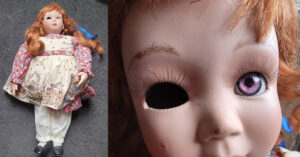 Confession! I have a doll phobia. They call it “paedophobia,” an intense irrational fear of a humanoid form when appearing too realistic, seemingly too close to becoming one of US. In fact, the more realistic the doll, the more frightened I become. Thus, when JP sent me a shocking doll photo, lacking an eye, I almost collapsed on my computer. First let me explain my reaction, then I’ll answer my reader’s request to research and put a value on her damaged-eye doll. By the way, she wrote that the eye is still rolling about in the head.
Confession! I have a doll phobia. They call it “paedophobia,” an intense irrational fear of a humanoid form when appearing too realistic, seemingly too close to becoming one of US. In fact, the more realistic the doll, the more frightened I become. Thus, when JP sent me a shocking doll photo, lacking an eye, I almost collapsed on my computer. First let me explain my reaction, then I’ll answer my reader’s request to research and put a value on her damaged-eye doll. By the way, she wrote that the eye is still rolling about in the head.
My first negative experience with a doll happened in San Diego. My longtime colleague Shawn and I worked late in our second-hand shop. At 9 pm I saw a dresser we recently purchased emitting an eerie green light from the bottom drawer. “Shawn! Come down from the office!” We both witnessed an old porcelain-faced doll in that drawer, off-gassing with a uranium colored light emission. Wouldn’t you develop a doll phobia from that moment on?
The Seat of Unease
In 1970 Masahiro Mori, an early professor of robotics, coined the term “The Uncanny Valley:” the closer AI or robots are to lifelike humans, the creepier we find them. In 2025, with current “artificial” technology’s peaks and valleys, we may experience much more fear around imitations of “being human.” Dr Mori said that ambiguity is the seat of the unease: is it one of us or one of THEM? If a humanoid object does something out of human character your stomach revolts. Imagine a mechanized clown doll bending backwards, and upside down, crablike, creeping toward you on all fours.
Many horror movies feature dolls, meant to bring on panic attacks and terror: Puppet Master, Annabelle, and, of course, Chucky. Those of us who hate to see human form maligned hate those type of movies. Like all irrational fears, no one knows the origin. The prescription for recovery often centers on constant exposure, not welcomed in my case. Echoing Murphy’s law, I often receive calls to appraisal a doll collection.
Now, the Doll in Question
A California dollmaker made her in the 1980s, a lady named Maurita Earline Brohmer, or she is also known as Earline Maples Brohmer (1938-2012). Born in Missouri, Brohmer relocated to Turlock, began a screen-printing business, and taught dollmaking classes. From 1983-2006 Doll Crafter magazine published her articles about how to make a porcelain faced doll. In March of 1999, Earline presented a three-day workshop in Menlo Park at a shop named Looking Glass Dolls & Bears, where students sculpted a head, hands, and feet with tools and supplies provided, for $300. Stranger than any coincidence, the very day the reader sent me that photo of Earline’s doll, it was exactly 26 years from Earline’s class in dollmaking.
One of the rare surviving doll shops, I wrote to the Vintage Toy Shoppe (est. 1975) in Richmond, VA. They DO buy antique dolls. Some of their vintage dolls, for example, are pricy: German artist Annette Himstedt eighteen inches tall dolls sell from $3-4k. Then there’s a limited-edition model, with porcelain face, German blown-glass eyes, 1997 date of creation, hand-knotted mohair wig, and a Belgian lace frilly dress, selling for $4,300 at the Richmond Virginia Vintage Toy Shoppe. I cannot imagine paying $4,000 to be endlessly haunted.
The type of doll the reader owns is indeed a porcelain faced doll, with porcelain hands and feet. Looks like she wears her original outfit, which makes a difference to a collector. The body of some dolls might be vinyl, composition (a mix of wood shavings and gesso), or resin, and some have an amateur of wire with which one can bend arms and legs, such as the series called Barefoot Children at the Vintage Toy Shop in Richmond. At this point, those Barefoot Children look too lifelike for me to stomach. The value of the reader’s doll—if she sent it to a doll hospital for repair—would be $75. I asked the reader to give the Vintage Doll Shop a call and ask if they know of any repair locations and fix up that eye before the doll scares another poor soul!